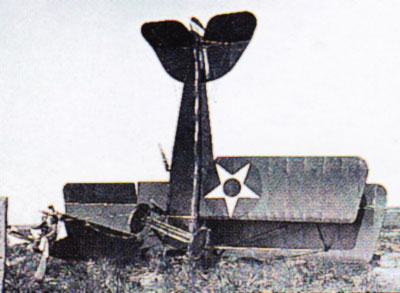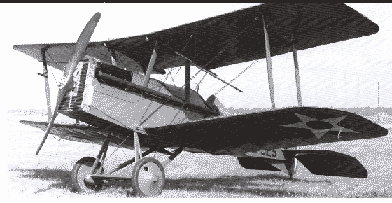


SE5a - $$4.50
The S.E.5 entered service with No. 56 Squadron RFC in March 1917 although the squadron did not deploy to the Western Front until the following month, among other reasons so that the very large "greenhouse" windscreens, unpopular with pilots, could be replaced with small rectangular screens of conventional design.
Billy Bishop's RAF SE5a British WWI Scout
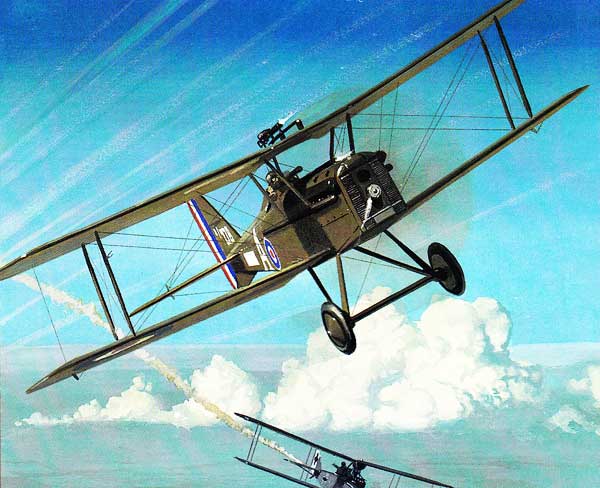
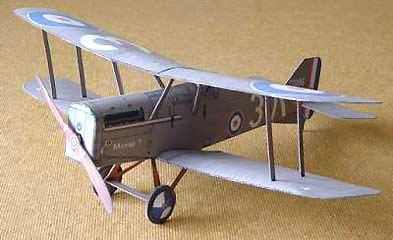
This Bulldog looking British fighter was superior in many ways to its opposing contemporaries.
It was built to take lots of punishment and still return home and was a very important Scout for the allies.
This little model even has a tiny Lewis machine gun that mounts on the wing. (not shown in picture).
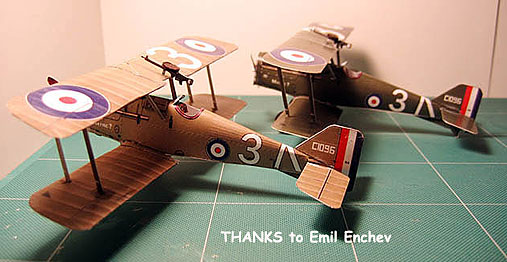 |
|
I want to share my joy
from the building of the two versions of SE5a. I send you
some pictures. More you can find in the FG forum. Sincerely!
Emil Enchev (Old Man) |
SE5a WWI British Scout and Billy Bishop
The SE5a, rival of the Camel for the title of the most successful
British fighter of the First W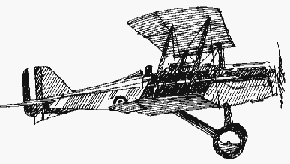 orld War, was designed by H. P.
Folland. J. Kenworthy and Major F. W. Goodden of the Royal Aircraft
Factory.
orld War, was designed by H. P.
Folland. J. Kenworthy and Major F. W. Goodden of the Royal Aircraft
Factory.
The prototype S.E.5, A4561, appeared in December 1916; it had the new 150 h.p. Hispano-Suiza engine with a car-type radiator and short exhaust manifolds. The wings had wire-braced spruce spars; in place of compression struts, some ribs were of solid construction. The tail-plane incidence could be changed in flight. A wire-braced wooden box girder, the fuselage was fabric-covered except for plywood sides from the nose to the front spar of the lower wing, with plywood round the cockpit. The main fuel tank was behind the engine, and there was a gravity tank to port of the center section.
In January 1917 the wings of the prototype collapsed in flight, and Major Goodden was killed. The main planes of subsequent machines were strengthened, their span was reduced and blunter tips were fitted. A few of the early production aircraft, however, retained the wing plan of the first two prototypes.
A Vickers gun, fixed on the port side of the fuselage with its breech inside the cockpit, fired through the air-screw by means of the Constantinesco synchronizing gear, A Lewis gun on a Foster mounting could be fired ahead over the top wing or directly upwards.
The type first went to France on April 7th, 1917, with No. 56 Squadron. The early machines had celluloid greenhouses over the cockpits; these were liable to be dangerous in a crash, so Major Blomfield, the CO., had them replaced by flat Triplex windscreens. The gravity tank was soon moved from the top of the wing to a position inside the center section. A few SE5s had faired head-rests.
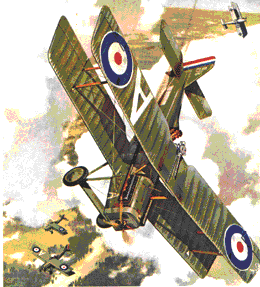 A modified version, the SE5a, powered by the 200 h.p. geared
Hispano-Suiza engine, was introduced in June 1917. It had a rather
deeper nose than that of the SES, radiator shutters and long exhaust
pipes. The standard faired head-rest was frequently removed to
improve the rearward view. From December 1917, the front struts
of the undercarriage vees were strengthened.
A modified version, the SE5a, powered by the 200 h.p. geared
Hispano-Suiza engine, was introduced in June 1917. It had a rather
deeper nose than that of the SES, radiator shutters and long exhaust
pipes. The standard faired head-rest was frequently removed to
improve the rearward view. From December 1917, the front struts
of the undercarriage vees were strengthened.
The geared 200 h.p. engine suffered from manufacturing faults, and there were frequent failures; in addition, engine construction lagged behind airframe manufacture, and the S.E.5a was not available in quantity until well into 1918. Eventually the Wolseley W.4a Viper 200 h.p. engine, based on the Hispano-Suiza, became standard and there were no more engine difficulties. The Viper's radiator was square and bulky, with short horizontal shutters.
Both friend and foe recognized the SE5a as a formidable fighting machine; it was fast, extremely strong and easy to fly. Superior to the Albatros D-III and D-V. the Pfalz D-III and the Fokker Dr-1. it was not outclassed when the excellent Fokker D-VII appeared in May 1918. It is significant that the SESa was the mount of Mannock (seventy-three victories), Bishop (seventy-two), McCudden (fifty-seven) and Beauchamp-Proctor (fifty-four). Some machines of No; 24 Squadron were rigged with reduced dihedral to improve their maneuverability. A total of 5,205 SE5s and 5as was constructed.
"The S.E.5 has turned out a dud... It's a great shame, for everybody expects such a lot from them... it is a rotten machine."
Albert Ball wrote these words in the spring of 1917, after he had been dragged back from active service on the Western Front, along with a group of Britain's finest pilots, to form a new fighter group based on the all-important Scout Experimental 5. The see-saw that was taking place in the skies over France had turned once again, this time Germany's way. The Albatros Scouts were faster, had a higher ceiling, could climb quicker and, above all, were out-gunning their Allied opponents.
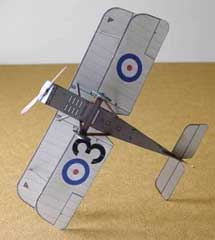 During the previous winter, the British Air Staff threw down the gauntlet to
the fledgling British aircraft industry. 'Build us', they said, 'a single-seater
with speed, maneuverability and armament superior to the enemy.' The challenge
was taken up by the Royal Aircraft Factory, based at Farnborough, and by Sopwith
Aviation. That both succeeded is now history. The S.E.5's only serious contender
for the best British fighter of World War I was the Sopwith Camel.
During the previous winter, the British Air Staff threw down the gauntlet to
the fledgling British aircraft industry. 'Build us', they said, 'a single-seater
with speed, maneuverability and armament superior to the enemy.' The challenge
was taken up by the Royal Aircraft Factory, based at Farnborough, and by Sopwith
Aviation. That both succeeded is now history. The S.E.5's only serious contender
for the best British fighter of World War I was the Sopwith Camel.
The Royal Aircraft Factory's design team of H.P. Folland, J. Kenworthy and Major F.W. Goodden was most impressed with a new aero-engine from Hispano-Suiza. Unlike so many successful engines of this time it did not have rotary cylinders. It was a water-cooled V8. It offered 150hp, a considerable increase over most engines currently available, yet with a weight of only 3301b. As a first step they installed the Hispano-Suiza 8A into the B.E.2c, which was being regularly shot out of the sky by Halberstadt's, Albatros and Roland's almost at will. This tremendous upsurge in power transformed the gentle old B.E. But power alone wasn't the answer. The aircraft required something extra.
The RAF designers went back to the drawing board and produced a tough square-rigged single-seater that made no compromises whatsoever to aesthetics. The S.E.5 was born to fly fast and hard. It gave the pilot excellent vision, but its greatest advantage was its built-in stability. The S.E.5's predecessors, the R.E.s and B.E.s, had needed stability for accurate observation. Now the much faster, more manoeuvrable S.E.5 would turn this into a priceless asset.
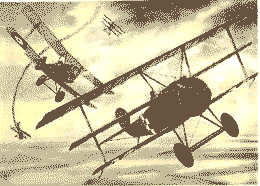
If you line your aircraft up behind your target and pull the trigger, you'll destroy your opponent much faster if you have a steady gun platform. That lesson, learned the hard way in the trenches below, was equally valid in the skies above. And so, despite their early protests, Britain's crack pilots began to train on the new aeroplane.
Albert Ball immediately took the Lewis gun off its mounting above the upper wing, preferring to rely on the Vickers with its Constantinesco synchronization. He re moved the cumbersome windscreen. He even lowered the seat by 8in. All this was carried out to increase the S.E.5's speed. At the time he believed the aircraft was slower than his beloved Nieuport, although this was not in fact the case.
In time, the British aces began to realize they were on to a winner. Despite its frumpish appearance, they found the S.E.5 was faster and had a higher ceiling than they had believed possible. More important, its fuel capacity gave an endurance of two and a half hours, which was much longer than the Albatros Scouts. So they would be able to climb high and stay high, waiting for the opposition to appear below them.
In March 1917 the S.E.5 was sent to France and had
an immediate impact on the war. But within months it was superseded
by the S.E.5a with an even more powerful version of the famous
engine designer Marc Birkigt's Hispano-Suiza engine, now developing
no less than 100 hp. Teething troubles with this engine, which
were also giving the French problems with the new SPAD, caused
the RAF factory to install a British-built version of the Hispano
Suiza, the Wolseley Viper. This engine also proved troublesome
and production was delayed while design defects were rectified.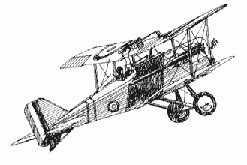
In all, over 5000 S.E.5s and S.E.5as were built, the vast majority being 5as with the more powerful engine. The aircraft remains a lesson to fighter designers of today speed and maneuverability, vital as they are, are not everything. If you cannot deliver your weapons from a stable platform, you are unlikely to achieve your objective. Although the S.E.5a accounted for fewer kills than its great Allied rival the Sopwith Camel, its total victory count ranks as one of the highest per aircraft of the war.
|
EBERHART SE-5E The SE-5E is an American-built version of the WW I S.E.5a designed by the Royal Aircraft Factory in Britain. The prototype S.E.5 first flew in December 1916 and deliveries of production S.E.5s began in March 1917. S.E.5a deliveries followed in June 1917. The S.E.5, noted for its strength, stability and speed, is said to have rivaled the Sopwith Camel as the most successful British fighter of WW I. The American Expeditionary Force bought 38 S.E.5a's in Britain and the design was selected for U.S. production. Orders were placed with the Curtiss Aeroplane and Motors Corp. but the Armistice halted production and only one Curtis S.E.5a was completed. Fifty-six more were assembled from components shipped from Britain. In the 1922-1923 period, 50 versions of the S.E.5a, now known as the SE-5E, were assembled in the U.S. by the Eberhart Steel Products Co. from spare parts it had produced. The Air Service used SE-E's primarily for training. |
BILLY BISHOP
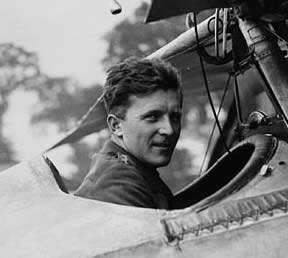 The most conspicuous symbol of the indomitable zeal in the RFC
was the charming Canadian roughneck Billy Bishop, who had managed
to get to the front as a combat pilot despite a checkered training
record that had landed him on home defense duty in England.
The most conspicuous symbol of the indomitable zeal in the RFC
was the charming Canadian roughneck Billy Bishop, who had managed
to get to the front as a combat pilot despite a checkered training
record that had landed him on home defense duty in England.
The chances were slim of a rookie pilot in a Nieuport surviving a face off with a new Albatros. But Billy Bishop responded to individual combat with a swift instinct that even the Richthofen brothers could not surpass. "I had a quick impulse," Bishop said, "and flew straight at the attacking machine." He drove the enemy plane into the ground with such a wild, gun-rattling dive that Bishop's own engine sputtered and seemed about to die. He saved himself with a lightning pull-out followed by a masterful landing in the shell-pocked mud, a bare 300 yards from the German line.
Billy Bishop had found his calling. German planes began to fall almost like rain before his guns: by the end of the summer of 1917 he had the astounding total of 47 victories. "I had found the one thing I loved above all others,he recalled. "To me it was not a business or a profession, but just a wonderful game."
Playing the game with a joyous vengeance, Bishop spent Easter Sunday engaging three planes and a balloon before taking on five German planes in a single-handed attack that left two planes burning on the ground-and left Bishop's squadron mates with the impression that "I was some sort of wild man from the zoo." Soon he was awarded the Military Cross and was granted permission to fly alone if he preferred- which he often did. One day in June he set off at dawn for a solitary raid on a German airfield far behind the lines. There, he reported, he destroyed three enemy planes, one after the other, as they rose to meet him. Although there were no friendly witnesses to confirm the exploit. Bishop received the Victoria Cross.
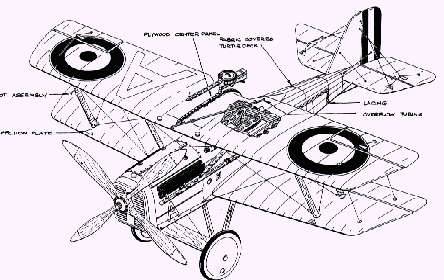
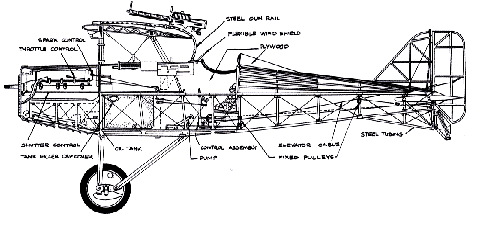
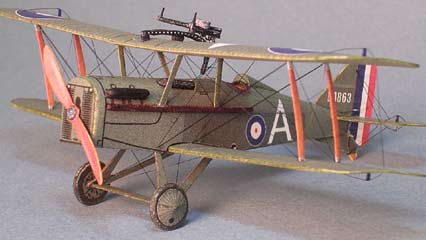
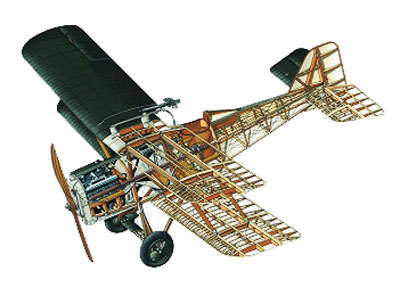
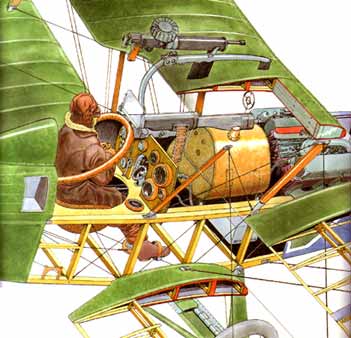
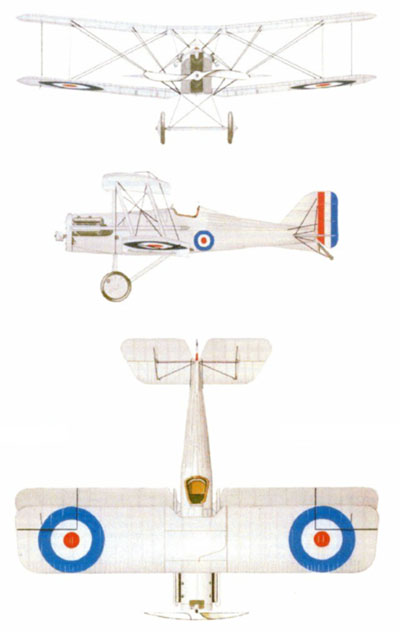
A long time ago, longer than I really care to remember, I built a rubber powered model of the SE 5a by Guillows. I spent a great deal of time hollowing out formers and sanding ad nauseum to lighten the framework prior to covering. The bird flew quite well and my efforts were rewarded. This WW 1 fighter has always been one of my favorites. The card model you put out is first class. All in all a neat airplane. Regards, Ed |
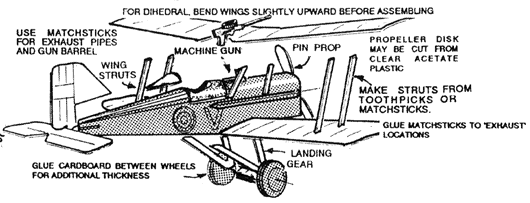
Specifications for the SE5a
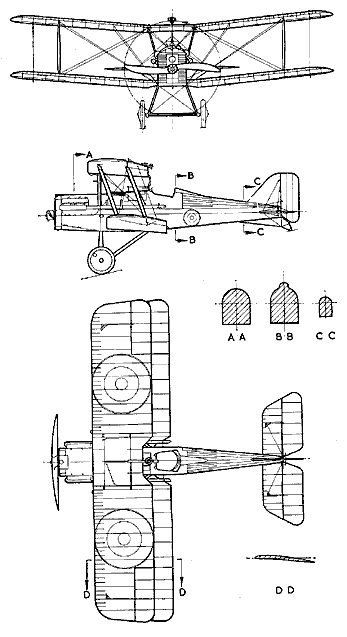 |
Length: 20 ft 11 in Armament |
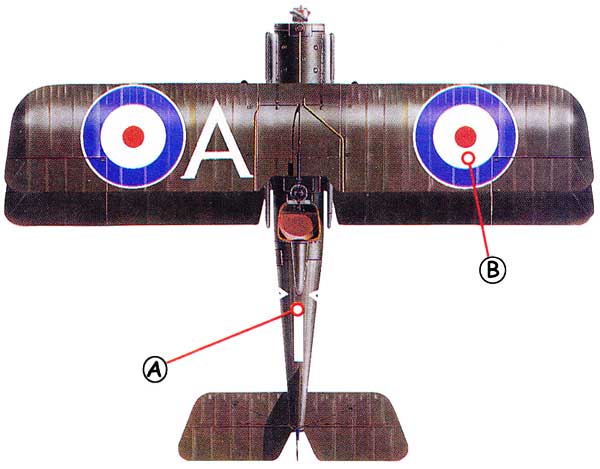 |
|
| A: Aircraft in World War I were built as light as possible to save weight. The skeleton frame was usually made of wood with a fabric skin. | B: All RFC aircraft carried large and vivid national markings, but like their counterparts in World War II they still found that friendly ground troops would shoot at them. |
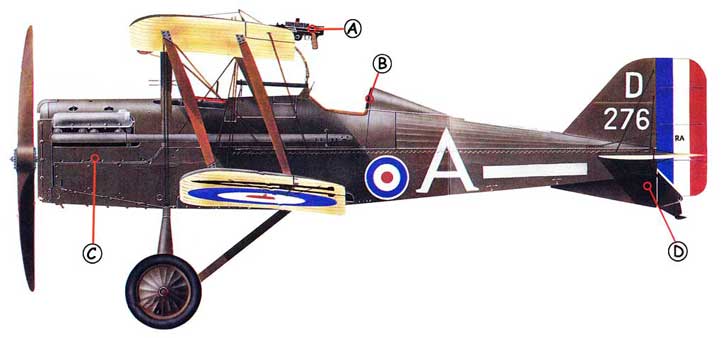 |
|||
| A: The Lewis machine gun mounted on the wing was magazine fed, and could be swung down on a rail to change its magazine. lt could also fire up. | B: Visibility from the S.E.5's cockpit was excellent, although the long inline engine obscured the view ahead more than in its snub- nosed contemporary, the Sopwith Camel. | C: The 200-hp. Hispano-Suiza engine gave the S.E.5 its superior speed. It had teething problems however and most aircraft had the less temperamental Wolseley Viper engine fitted instead. | D: The wedge-shaped tail, which was much more modern-looking than those of its contemporaries, was a key recognition feature of the S.E.5. |
Some videos for you
Below are some videos of a walk-around of The Royal Aircraft Factory SE.5a Biplane Fighter and some fantastic historical footage of Billy Bishop.
This one is an interesting and informative interview of an actual WWI pilot who flew the S.E.5
